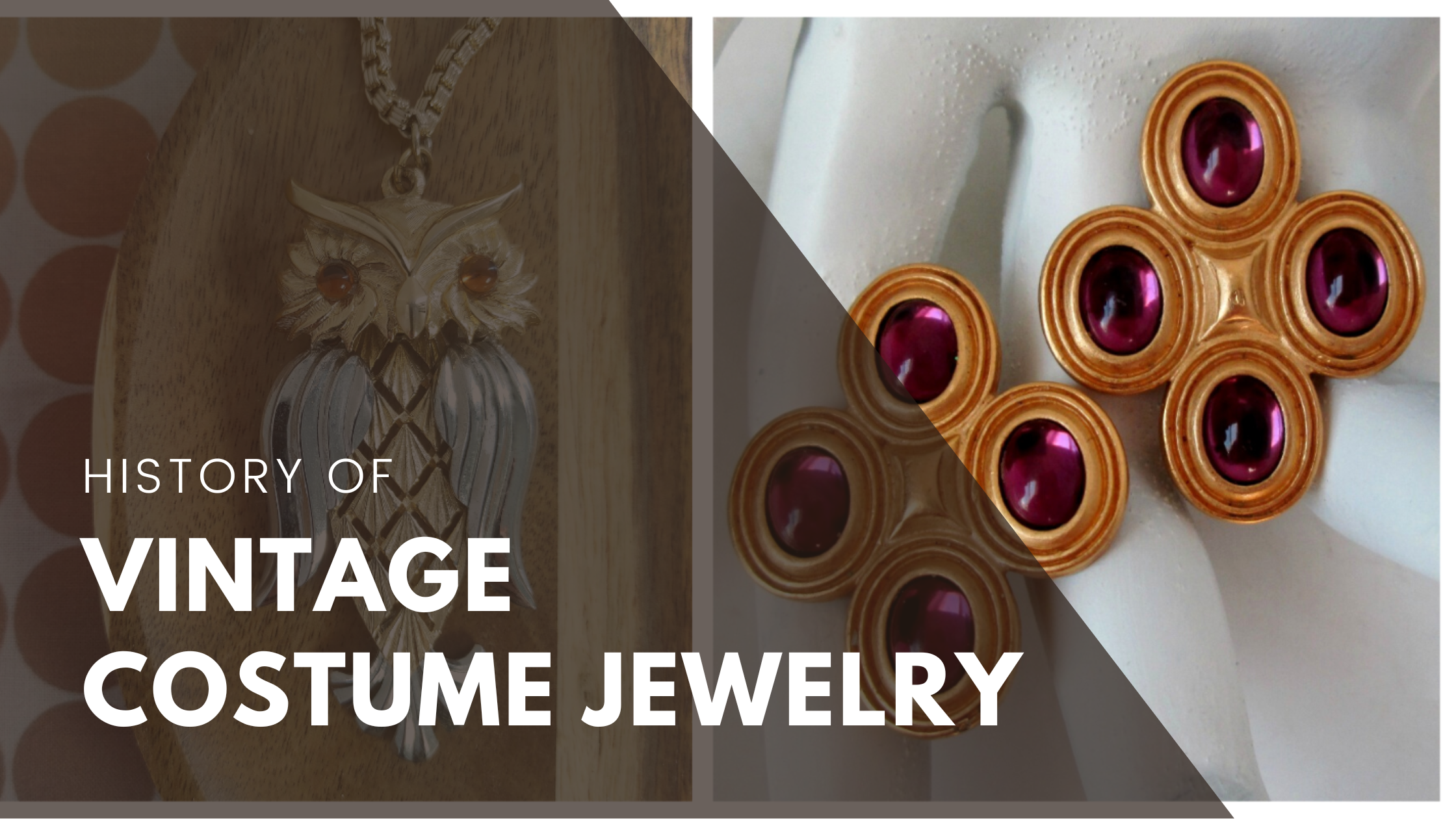Glitz and Glamour: Traversing the Eras of Costume Jewelry's Glamorous History
Vintage costume jewelry is a fascinating and beloved category of jewelry that has captured the hearts of collectors and fashion enthusiasts alike. While today's fashion jewelry market is filled with options that draw inspiration from past eras, there is a certain charm and allure to the originals that have stood the test of time.
The history of vintage costume jewelry is rich and exciting, filled with stories of innovation, creativity, and the changing fashion trends of different eras. From the early 20th century to the present day, costume jewelry has evolved to reflect the styles and materials of each period, offering a unique glimpse into the fashion and culture of the times.
In this blog post, we will explore the fascinating history of vintage costume jewelry, its origins, key designers and styles, and its enduring appeal in today's fashion world. Whether you are a seasoned collector or simply curious about this captivating jewelry category, this post will offer a comprehensive overview of the evolution and impact of vintage costume jewelry throughout the years.
What is Costume Jewelry?
Costume jewelry, also known as fashion jewelry or imitation jewelry, is made with non-precious materials such as base metals, plastic, glass, and synthetic stones. Unlike fine jewelry, made with precious metals and gemstones, costume jewelry is primarily designed for fashion purposes and is intended to complement an outfit or make a statement.
Costume jewelry can be found in various styles and designs, from simple and understated to bold and ornate. It can include necklaces, bracelets, earrings, and brooches and may be decorated with embellishments such as beads, rhinestones, enamel, and more. While costume jewelry is typically more affordable than fine jewelry, there are also higher-end costume jewelry brands that can be pretty expensive.
The First Wave of Costume Jewelry
The first wave of costume jewelry emerged in the early 20th century, a time of significant change and innovation in fashion and jewelry design. With the advent of new materials such as Bakelite and celluloid, jewelry makers could experiment with new forms and techniques that were both affordable and stylish.
One of the pioneers of this era was Coco Chanel, who revolutionized the fashion world with her bold, avant-garde designs. Her designs were a departure from the traditional, delicate styles of fine jewelry and instead focused on bold shapes and striking colors. Chanel's costume jewelry pieces were made with non-precious materials such as glass, faux pearls, and enamel and were often oversized and asymmetrical.
Another critical designer of this era was Miriam Haskell, who founded her eponymous jewelry brand in 1924. Haskell's designs were known for their intricate beadwork and attention to detail and often incorporated elements such as filigree, pearls, and rhinestones. Her designs were popular with Hollywood actresses of the time, and her brand continues to be highly regarded by collectors today.
Other notable designers of the first wave of costume jewelry include Elsa Schiaparelli, whose designs were bold with surrealistic motifs, and Trifari, known for their quality and craftsmanship. Together, these designers helped to establish costume jewelry as a legitimate and desirable category of jewelry, paving the way for future generations of designers and collectors.
Hollywood’s Influence on Costume Jewelry
Hollywood has significantly influenced vintage costume jewelry, particularly during the golden age of cinema in the 1930s and 1940s. Movie stars of the era wore bold, eye-catching jewelry on and off screen, which helped to popularize costume jewelry as a fashionable and affordable alternative to fine jewelry.
One of the most famous examples of Hollywood's influence on vintage jewelry is the "bib" necklace worn by Claudette Colbert in the 1934 film "Cleopatra." The necklace, which jewelry maker Roger Scemama designed, featured a dramatic collar of golden beads and rhinestones that covered Colbert's chest. The necklace became an instant sensation, and similar styles quickly became popular among women who wanted to emulate Colbert's glamorous look.
Another example of Hollywood's influence on vintage jewelry is the popularity of brooches during the 1940s. Movie stars such as Joan Crawford and Bette Davis often wore elaborate brooches on their lapels or hair, which helped cement the accessory as a must-have item for fashionable women. Brooches of the era often featured bold, abstract designs and were adorned with rhinestones or colored glass.
Hollywood's influence on vintage jewelry also extended beyond the silver screen. Movie stars often wore their personal jewelry collections to public events and parties, which helped to popularize certain styles and designs. For example, actress Elizabeth Taylor was known for her love of jewelry, particularly diamonds and other precious stones. Her collection included several iconic pieces, such as the 33-carat Krupp diamond ring given to her by Richard Burton.
Vintage Jewelry and the ‘90s
The 1990s marked a significant fashion and jewelry design shift, with many designers looking back to vintage styles and motifs for inspiration. Vintage costume jewelry, in particular, experienced a resurgence in popularity during this decade as fashion-conscious consumers sought out unique and eclectic accessories to complement their outfits.
Art Deco was one of the most popular styles of vintage jewelry during the 1990s. Characterized by bold geometric shapes and bright, contrasting colors, Art Deco jewelry reflected the exuberance and optimism of the 1920s and 1930s. Designers such as Kenneth Jay Lane and Chanel incorporated Art Deco elements into their designs, creating statement pieces that were both elegant and eye-catching.
Another popular style of vintage jewelry during the 1990s was Victorian-inspired jewelry. Victorian-inspired jewelry was worn in layers, with multiple necklaces or bracelets stacked together for a romantic and feminine look. Intricate filigree work, delicate seed pearls, and colored stones such as amethyst and garnet characterized this style.
The popularity of vintage jewelry during the 1990s has been attributed to the rise of retro and vintage-inspired fashion by style historians. Designers such as Betsey Johnson and Marc Jacobs drew inspiration from vintage styles. They incorporated them into their collections, creating a trend for quirky and eclectic fashion that was popular among young consumers.
Vintage jewelry also appealed to consumers looking for unique and sustainable alternatives to mass-produced accessories. By wearing vintage jewelry, consumers could express their individuality and reduce their environmental impact by giving new life to pre-loved pieces.
The Resurgence of Vintage Costume Jewelry
In the 21st century, there has been a significant resurgence in the popularity of vintage costume jewelry. Fashion-conscious consumers have embraced vintage jewelry to express their individuality and add a unique touch to their outfits.
One of the main drivers of the resurgence of vintage costume jewelry has been the rise of sustainable fashion. By choosing vintage jewelry, consumers can give new life to pre-loved pieces and reduce the demand for new, mass-produced items. Consumers are increasingly aware of the environmental impact of fast fashion and are looking for ways to reduce their carbon footprint.
Another factor contributing to the resurgence of vintage costume jewelry is the desire for one-of-a-kind accessories. With mass-produced jewelry flooding the market, many consumers seek unique pieces that reflect their style. Vintage jewelry offers a range of styles and designs that can't be found in modern jewelry stores, making it a popular choice for those seeking something special.
Social media has also played a role in the resurgence of vintage costume jewelry. Platforms such as Instagram and Pinterest have made it easier for consumers to discover vintage jewelry and see examples of how it can be incorporated into modern outfits. Influencers and celebrities have also been spotted wearing vintage jewelry, further increasing its popularity among fashion-conscious consumers.
Finally, the affordability of vintage costume jewelry has also contributed to its resurgence. With the rising cost of gold and other precious metals, many consumers turn to more affordable alternatives, such as vintage costume jewelry. Vintage pieces offer a unique and stylish alternative to fine jewelry at a fraction of the cost.
Today, vintage costume jewelry remains popular among collectors and fashion enthusiasts. Whether you're drawn to the bold colors and shapes of Art Deco jewelry or the delicate filigree work of Victorian-inspired pieces, vintage jewelry offers a unique and timeless way to express your style and reduce your environmental impact.







